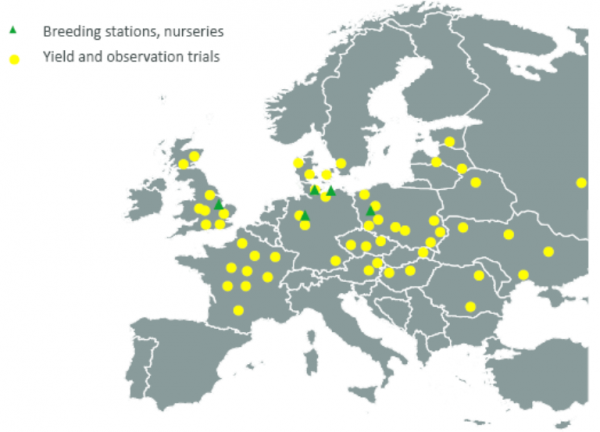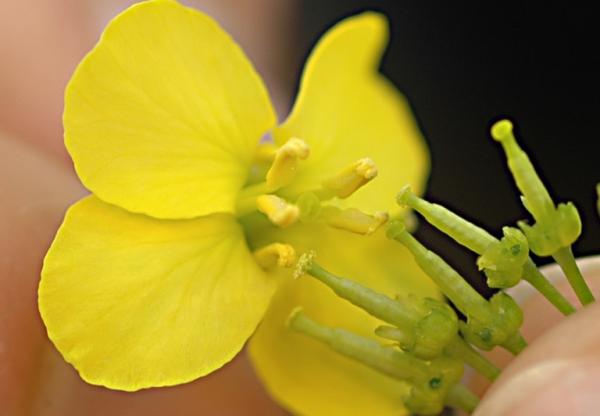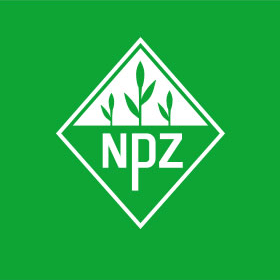Winter Oilseed Rape
Since 1897, NPZ is breeding different crops, and winter oilseed rape has been one of them from the start. That is why our breeding company can give evidence of 120 years of rapeseed breeding history – the longest experience with oilseed rape in Germany.
NPZ has a close breeding-cooperation with Deutsche Saatveredelung AG (DSV) which is also our distribution partner in the RAPOOL-Ring. Another breeding cooperation exists with the French company RAGT/R2n.
NPZ pursues a large European breeding programme for winter oilseed rape with focal areas throughout Middle, Western, Northern and Eastern Europe. In all these regions, we have established an extensive test network which is used to internally pre-check our most promising hybrids ahead of the official examination of varieties.
Our breeding stations are located in Hohenlieth/Holtsee, Malchow/island of Poel, Hovedissen/Leopoldshöhe, Gola (Poland) and Cambridge (UK).
In winter oilseed rape, NPZ focuses exclusively on hybrid breeding. Each hybrid is based on a crossing between selected maternal and paternal lines. For breeding these two parental components, new material is continuously developed in the existing gene pools. When selecting elite lines for promising hybrid combinations, gene pool differentiation is the key for breeding success. When breeding hybrids of winter oilseed rape, NPZ uses the MSL-system (male sterility Lembke) as well as the Ogura-system developed by INRA (Institut national de la recherche agronomique).

Further to classical breeding objectives such as increasing grain yield and oil content, improving agronomic properties and the selection of pathogen resistances is of particular importance in the breeding of winter oilseed rape. NPZ is a forerunner in club-root resistance breeding, and with MENDEL was able to introduce the world’s first club-root resistant variety into the market. The selection for resistance against Phoma, Verticillium, Cylindrosporium and TuYV (Turnip Yellow Virus) is also firmly established in our breeding activities.

NPZ is not only active in breeding double-zero winter rape (use of the harvested crop for edible oil and biodiesel) but also pursues the special breeding of varieties with higher erucic acid content (HEAR) for industrial purposes and HOLLi-varieties (high erucic acid content, low linolenic acid content).
Milestones: Winter Oilseed Rape
“The pathway to the healthiest edible oil, environmentally friendly biofuel and high-grade animal feed” – breeding progress by the example of winter oilseed rape
Successes in quality breeding with improvements in the quality of rapeseed oil and meal were prerequisite for the global increase of cropland used for oilseed rape. Following the revolution of rapeseed oil that was caused by the introduction of the first low-erucic acid varieties (0-varieties) at the beginning of the 1970s, quality of animal feed was improved in the mid-1980s when varieties low in glucosinolate (double-zero varieties) were introduced.
Today, and due to the high content of mono-unsaturated fats, the favourable relation of poly-unsaturated omega-3 fatty acids and omega-6 fatty acids, and the very low content of saturated fats, rapeseed oil is at the top of nutritionally valuable edible oils. In addition, and as a consequence of the growing relevance of renewable resources, rapeseed oil is used energetically in its pure form, and as biodiesel or rapeseed oil methyl ester fuel (RME).
The rapeseed meal derived after the extraction of the oil is used as a high-value source of protein in animal feed. In the future, varieties featuring particularly low glucosinolate contents could further enhance the percentage of rapeseed meal in feed rations, thus reducing Europe’s dependence on soy meal imports.
Since the introduction of hybrid varieties in Germany in 1996, annual yield increases of about 0.9 quintals per hectare have been achieved in agricultural practice.
In the EU 28, cropland used for oilseed rape has more than doubled from three to well over six million hectares in the past decade. Oilseed rape is the EU 28’s most important oil crop (> 6.6 million hectares as of 2017), and, following oil palms and soybeans, is the third most important oil crop globally.
Winter Oilseed Rape – a success story
1973
LESIRA The world’s first erucic acid-free winter oilseed rape variety (0-quality)
1978
LEDOS The world’s first winter oilseed rape variety in 00-quality - free of erucic acid and low in glucosinolates – receives plant variety protection
1986
CERES The first leading European line variety in 00-quality
1993
EXPRESS Increased harvest-index and oil content, improved resistance against lodging and fungal diseases
1995
JOKER & PRONTO The world’s first fully-restored winter oilseed rape hybrids created using the MSL hybrid system (Male Sterility Lembke)
2000
MENDEL First club root resistant hybrid receives approval
2000
TALENT Market leading hybrids in Germany
2006
TRABANT & TITAN Market leading hybrids in Germany
2008/10
VISBY, ROHAN & SHERPA European-wide cultivation
2011/13
AVATAR & MERCEDES New high-performing, oil-rich hybrids
2014
PENN & MENTOR New hybrid genetics
MENTOR High yielding, clubroot resistant hybrid
2017
HATTRICK – Best performing variety registered in Dec. 2016
2018
PUZZLE & CROME
New yield perspectives
CROME The new generation with clubroot resistance

